Canadian Energy Centre
B.C. First Nation buying ‘ready-to-go’ natural gas pipeline to supply LNG project
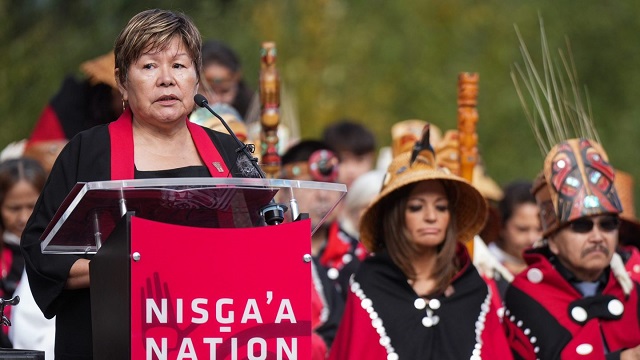
Eva Clayton, president of the Nisga’a Lisims Government, speaks during a homecoming celebration for the House of Ni’isjoohl memorial totem at the Nisga’a Nation, in Laxgalts’ap, B.C., Friday, Sept. 29, 2023. CP Images photo
From the Canadian Energy Centre
By Will Gibson‘It is an opportunity for us to create a better quality of life for our children and grandchildren’
Momentum continues building for Indigenous-led Canadian liquefied natural gas (LNG), with a second project securing a pipeline connection.
The Nisga’a Nation, a small coastal community near B.C.’s border with Alaska, announced earlier this month it will purchase TC Energy’s Prince Rupert Gas Transmission project along with partner Western LNG.
It’s a turning point for the proposed Ksi Lisims LNG project, particularly because the pipeline has all the permits it needs to go ahead, said market analyst Ian Archer.
“Buying this asset, a permitted and ready-to-build natural gas pipeline, puts control in the hands of the project’s partners,” said Archer, S&P Global’s associate director for gas, power and climate solutions.
“The Nisga’a Nation and Western LNG now have control over the timeline and development of their proposed development. It’s a great day for them and the LNG industry in B.C.”
The purchase comes after years of uncertainty for the proposed 900-kilometre pipeline, which would run from Hudson’s Hope in northeast B.C. to Lelu Island, near Prince Rupert.
It was originally supposed to supply the $36-billion Pacific NorthWest LNG project, which was cancelled in 2017.
In 2014, the Nisga’a Nation signed an agreement for construction of the pipeline through its traditional lands. Today, Nisga’a president Eva Clayton says becoming an owner of the project ensures it will provide even greater benefits.
Nisga’a Nation and Western LNG to purchase PRGT natural gas projecthttps://t.co/jPVDa3jzQP pic.twitter.com/Er6ugtTlkV
— NLG – Nisga'a Nation (@NLGNisgaaNation) March 14, 2024
“This means more training, more priority hiring, more contracts and procurement for our workers and businesses, and more investment in our nation,” Clayton said.
“It is a historic development, and an opportunity for us to create a better quality of life for our children and grandchildren here in the Nass – and for First Nations all along the pipeline route.”
Ksi Lisims is a proposed floating facility with capacity to export 12 million tonnes of LNG per year. It is owned by the Nisga’a Nation, Western LNG, and Rockies LNG – a consortium that includes some of Canada’s largest natural gas producers.
Archer, who has spent more than 20 years analyzing the energy sector, sees the partnership as a template for the future.
“The trend now is Indigenous participation in energy developments is seen as a given as opposed to just engagement or consultation with communities,” he says.
“There is a recognition by both energy producers and Indigenous communities that they have a vested interest in exploring and participating in partnerships to responsibly develop oil and gas and build critical infrastructure to support that. That trend will continue to grow because it makes sense for everybody.”
The momentum is building for Ksi Lisims – which also recently signed on Shell as a long-term LNG buyer and filed its regulatory application for an environmental certificate – hot on the heels of Cedar LNG, another Indigenous-led project on the B.C. coast.
Cedar LNG, owned jointly by the Haisla Nation and Pembina Pipeline Corporation, has regulatory approval to proceed and is preparing for construction to start. A final investment decision is expected by the middle of this year.
Cedar’s pipeline is already in the ground. It will be served by Coastal GasLink, a 670-kilometre pipeline from northeast B.C. to Kitimat that was completed late last year.
The project was built primarily to feed the LNG Canada terminal, which is now more than 85 per cent complete.
Less than a kilometre of connecting pipeline – called Cedar Link – would need to be built to get gas flowing to the Indigenous-owned Cedar LNG project.
Given the appetite for LNG for potential customers in Asia (expected to drive a nearly 70 per cent increase in global demand through 2040), Clayton sees Ksi Lisims as key for providing opportunities for her community.
“For far too long, First Nations could only watch as others built generational wealth from the resources of our traditional lands. But times are changing. Our ownership role in this pipeline signals a new era for Indigenous participation in Canada’s economy.”
Canadian Energy Centre
Alberta oil sands legacy tailings down 40 per cent since 2015
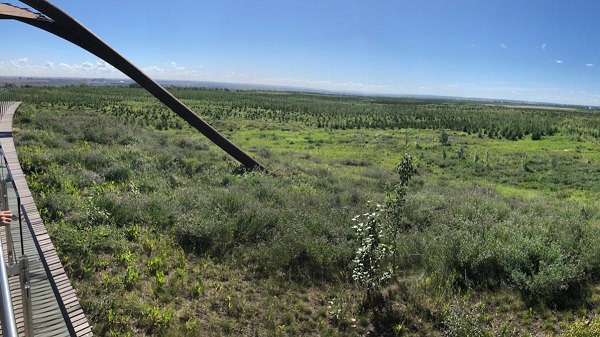
Wapisiw Lookout, reclaimed site of the oil sands industry’s first tailings pond, which started in 1967. The area was restored to a solid surface in 2010 and now functions as a 220-acre watershed. Photo courtesy Suncor Energy
From the Canadian Energy Centre
By CEC Research
Mines demonstrate significant strides through technological innovation
Tailings are a byproduct of mining operations around the world.
In Alberta’s oil sands, tailings are a fluid mixture of water, sand, silt, clay and residual bitumen generated during the extraction process.
Engineered basins or “tailings ponds” store the material and help oil sands mining projects recycle water, reducing the amount withdrawn from the Athabasca River.
In 2023, 79 per cent of the water used for oil sands mining was recycled, according to the latest data from the Alberta Energy Regulator (AER).
Decades of operations, rising production and federal regulations prohibiting the release of process-affected water have contributed to a significant accumulation of oil sands fluid tailings.
The Mining Association of Canada describes that:
“Like many other industrial processes, the oil sands mining process requires water.
However, while many other types of mines in Canada like copper, nickel, gold, iron ore and diamond mines are allowed to release water (effluent) to an aquatic environment provided that it meets stringent regulatory requirements, there are no such regulations for oil sands mines.
Instead, these mines have had to retain most of the water used in their processes, and significant amounts of accumulated precipitation, since the mines began operating.”
Despite this ongoing challenge, oil sands mining operators have made significant strides in reducing fluid tailings through technological innovation.
This is demonstrated by reductions in “legacy fluid tailings” since 2015.
Legacy Fluid Tailings vs. New Fluid Tailings
As part of implementing the Tailings Management Framework introduced in March 2015, the AER released Directive 085: Fluid Tailings Management for Oil Sands Mining Projects in July 2016.
Directive 085 introduced new criteria for the measurement and closure of “legacy fluid tailings” separate from those applied to “new fluid tailings.”
Legacy fluid tailings are defined as those deposited in storage before January 1, 2015, while new fluid tailings are those deposited in storage after January 1, 2015.
The new rules specified that new fluid tailings must be ready to reclaim ten years after the end of a mine’s life, while legacy fluid tailings must be ready to reclaim by the end of a mine’s life.
Total Oil Sands Legacy Fluid Tailings
Alberta’s oil sands mining sector decreased total legacy fluid tailings by approximately 40 per cent between 2015 and 2024, according to the latest company reporting to the AER.
Total legacy fluid tailings in 2024 were approximately 623 million cubic metres, down from about one billion cubic metres in 2015.
The reductions are led by the sector’s longest-running projects: Suncor Energy’s Base Mine (opened in 1967), Syncrude’s Mildred Lake Mine (opened in 1978), and Syncrude’s Aurora North Mine (opened in 2001). All are now operated by Suncor Energy.
The Horizon Mine, operated by Canadian Natural Resources (opened in 2009) also reports a significant reduction in legacy fluid tailings.
The Muskeg River Mine (opened in 2002) and Jackpine Mine (opened in 2010) had modest changes in legacy fluid tailings over the period. Both are now operated by Canadian Natural Resources.
Imperial Oil’s Kearl Mine (opened in 2013) and Suncor Energy’s Fort Hills Mine (opened in 2018) have no reported legacy fluid tailings.
Suncor Energy Base Mine
Between 2015 and 2024, Suncor Energy’s Base Mine reduced legacy fluid tailings by approximately 98 per cent, from 293 million cubic metres to 6 million cubic metres.
Syncrude Mildred Lake Mine
Between 2015 and 2024, Syncrude’s Mildred Lake Mine reduced legacy fluid tailings by approximately 15 per cent, from 457 million cubic metres to 389 million cubic metres.
Syncrude Aurora North Mine
Between 2015 and 2024, Syncrude’s Aurora North Mine reduced legacy fluid tailings by approximately 25 per cent, from 102 million cubic metres to 77 million cubic metres.
Canadian Natural Resources Horizon Mine
Between 2015 and 2024, Canadian Natural Resources’ Horizon Mine reduced legacy fluid tailings by approximately 36 per cent, from 66 million cubic metres to 42 million cubic metres.
Total Oil Sands Fluid Tailings
Reducing legacy fluid tailings has helped slow the overall growth of fluid tailings across the oil sands sector.
Without efforts to reduce legacy fluid tailings, the total oil sands fluid tailings footprint today would be approximately 1.6 billion cubic metres.
The current fluid tailings volume stands at approximately 1.2 billion cubic metres, up from roughly 1.1 billion in 2015.
The unaltered reproduction of this content is free of charge with attribution to the Canadian Energy Centre.
Business
Why it’s time to repeal the oil tanker ban on B.C.’s north coast
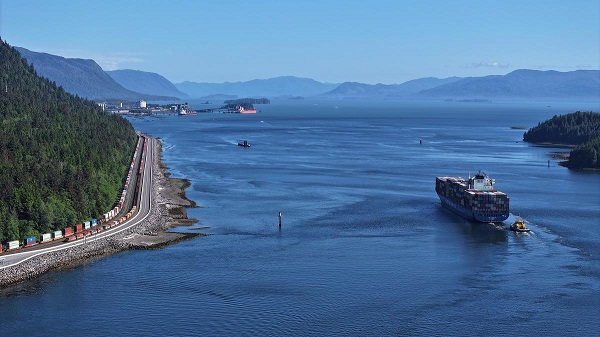
The Port of Prince Rupert on the north coast of British Columbia. Photo courtesy Prince Rupert Port Authority
From the Canadian Energy Centre
By Will Gibson
Moratorium does little to improve marine safety while sending the wrong message to energy investors
In 2019, Martha Hall Findlay, then-CEO of the Canada West Foundation, penned a strongly worded op-ed in the Globe and Mail calling the federal ban of oil tankers on B.C.’s northern coast “un-Canadian.”
Six years later, her opinion hasn’t changed.
“It was bad legislation and the government should get rid of it,” said Hall Findlay, now director of the University of Calgary’s School of Public Policy.
The moratorium, known as Bill C-48, banned vessels carrying more than 12,500 tonnes of oil from accessing northern B.C. ports.
Targeting products from one sector in one area does little to achieve the goal of overall improved marine transport safety, she said.
“There are risks associated with any kind of transportation with any goods, and not all of them are with oil tankers. All that singling out one part of one coast did was prevent more oil and gas from being produced that could be shipped off that coast,” she said.
Hall Findlay is a former Liberal MP who served as Suncor Energy’s chief sustainability officer before taking on her role at the University of Calgary.
She sees an opportunity to remove the tanker moratorium in light of changing attitudes about resource development across Canada and a new federal government that has publicly committed to delivering nation-building energy projects.
“There’s a greater recognition in large portions of the public across the country, not just Alberta and Saskatchewan, that Canada is too dependent on the United States as the only customer for our energy products,” she said.
“There are better alternatives to C-48, such as setting aside what are called Particularly Sensitive Sea Areas, which have been established in areas such as the Great Barrier Reef and the Galapagos Islands.”
The Business Council of British Columbia, which represents more than 200 companies, post-secondary institutions and industry associations, echoes Hall Findlay’s call for the tanker ban to be repealed.
“Comparable shipments face no such restrictions on the East Coast,” said Denise Mullen, the council’s director of environment, sustainability and Indigenous relations.
“This unfair treatment reinforces Canada’s over-reliance on the U.S. market, where Canadian oil is sold at a discount, by restricting access to Asia-Pacific markets.
“This results in billions in lost government revenues and reduced private investment at a time when our economy can least afford it.”
The ban on tanker traffic specifically in northern B.C. doesn’t make sense given Canada already has strong marine safety regulations in place, Mullen said.
Notably, completion of the Trans Mountain Pipeline expansion in 2024 also doubled marine spill response capacity on Canada’s West Coast. A $170 million investment added new equipment, personnel and response bases in the Salish Sea.
“The [C-48] moratorium adds little real protection while sending a damaging message to global investors,” she said.
“This undermines the confidence needed for long-term investment in critical trade-enabling infrastructure.”
Indigenous Resource Network executive director John Desjarlais senses there’s an openness to revisiting the issue for Indigenous communities.
“Sentiment has changed and evolved in the past six years,” he said.
“There are still concerns and trust that needs to be built. But there’s also a recognition that in addition to environmental impacts, [there are] consequences of not doing it in terms of an economic impact as well as the cascading socio-economic impacts.”
The ban effectively killed the proposed $16-billion Eagle Spirit project, an Indigenous-led pipeline that would have shipped oil from northern Alberta to a tidewater export terminal at Prince Rupert, B.C.
“When you have Indigenous participants who want to advance these projects, the moratorium needs to be revisited,” Desjarlais said.
He notes that in the six years since the tanker ban went into effect, there are growing partnerships between B.C. First Nations and the energy industry, including the Haisla Nation’s Cedar LNG project and the Nisga’a Nation’s Ksi Lisims LNG project.
This has deepened the trust that projects can mitigate risks while providing economic reconciliation and benefits to communities, Dejarlais said.
“Industry has come leaps and bounds in terms of working with First Nations,” he said.
“They are treating the rights of the communities they work with appropriately in terms of project risk and returns.”
Hall Findlay is cautiously optimistic that the tanker ban will be replaced by more appropriate legislation.
“I’m hoping that we see the revival of a federal government that brings pragmatism to governing the country,” she said.
“Repealing C-48 would be a sign of that happening.”
-

 Also Interesting1 day ago
Also Interesting1 day ago9 Things You Should Know About PK/PD in Drug Research
-
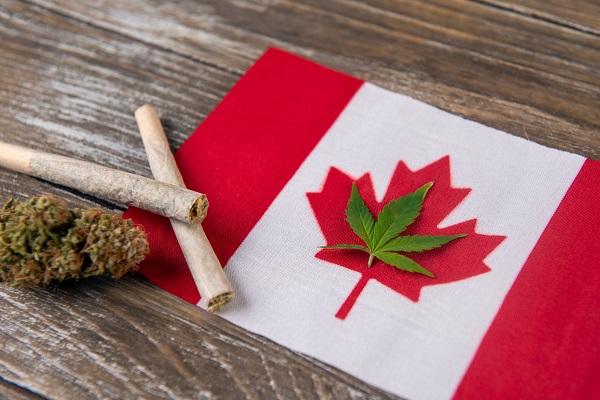
 Business1 day ago
Business1 day agoCannabis Legalization Is Starting to Look Like a Really Dumb Idea
-

 Business2 days ago
Business2 days ago‘Experts’ Warned Free Markets Would Ruin Argentina — Looks Like They Were Dead Wrong
-
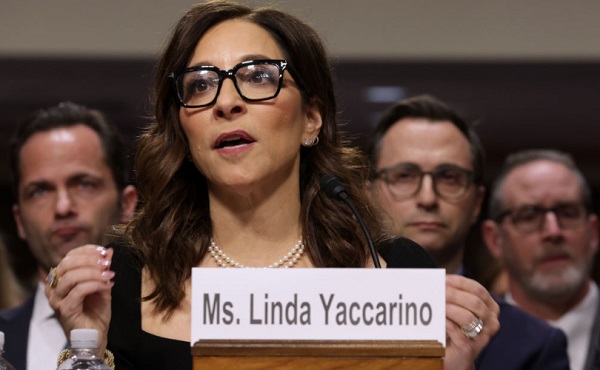
 Business2 days ago
Business2 days agoWEF-linked Linda Yaccarino to step down as CEO of X
-

 Business1 day ago
Business1 day agoCarney government should recognize that private sector drives Canada’s economy
-

 Bruce Dowbiggin1 day ago
Bruce Dowbiggin1 day agoThe Covid 19 Disaster: When Do We Get The Apologies?
-

 Media1 day ago
Media1 day agoCBC journalist quits, accuses outlet of anti-Conservative bias and censorship
-

 Automotive2 days ago
Automotive2 days agoAmerica’s EV Industry Must Now Compete On A Level Playing Field













